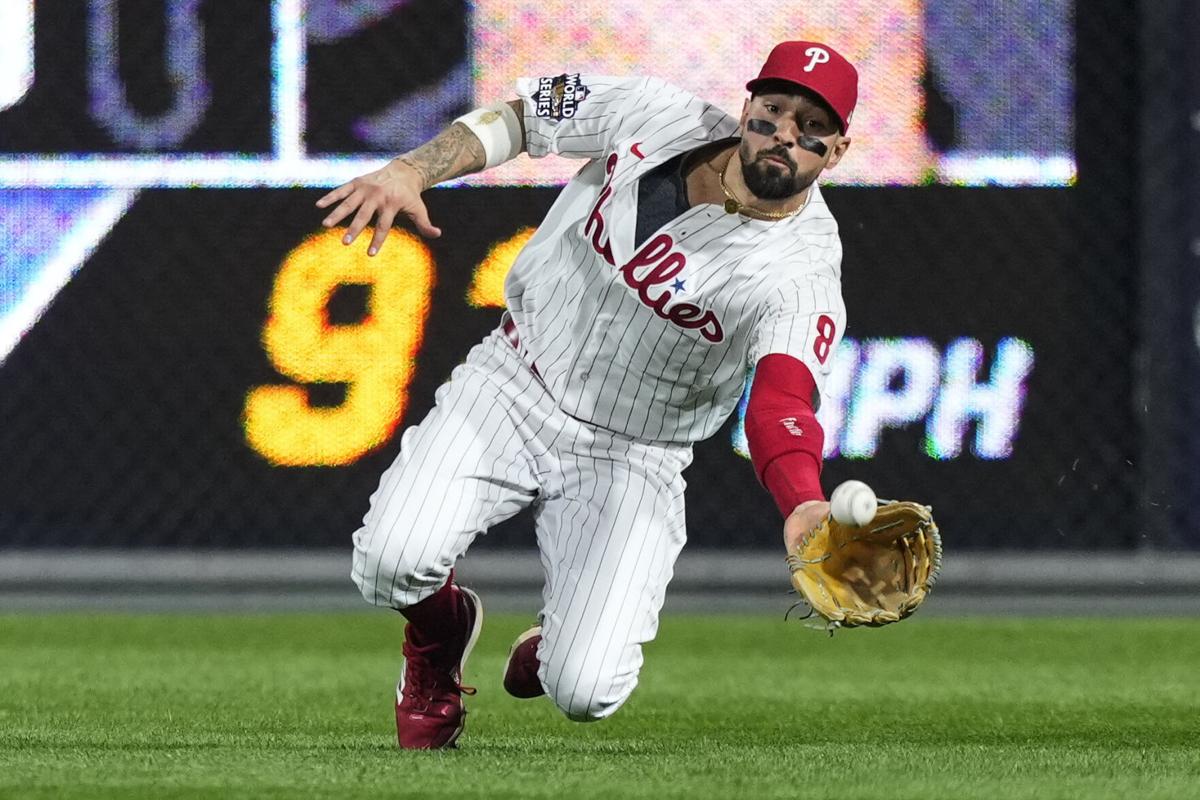Game 1 of the Phillies-Astros World Series required 4 hours and 34 minutes. Yes, it was 10 innings, but c’mon. Monday night’s NFL game, Browns vs. Bengals, was played in 3:07.
Which one would you prefer to watch?
In the public mind, the sad decline of the World Series has never been more profound than the way ESPN treated the World Series immediately following the Browns-Bengals post-game show.
The one-hour Scott Van Pelt “SportsCenter” did not include a mention of the World Series. Unless I lost consciousness for a few seconds, there wasn’t a whisper that Game 3 had been rained out, let alone a segment on the Fall (not-so) Classic.
Producers of the SVP show aired three segments on the Browns-Bengals game, news stories about Michigan State football players assaulting a Michigan State player, a story about Auburn firing football coach Bryan Harsin, a lengthy segment — Bad Beats — about four college football games that created havoc among bettors, highlights of four NBA games, a segment about the playoff possibilities of all NFL teams, a segment about the possibility of the Browns trading running back Kareem Hunt, and, finally, highlights of former Arizona shooting whiz Lauri Markkanen scoring 31 points against Memphis.
Not a word on the World Series until a follow-up, late-night “SportsCenter” that began at 9:30 p.m. Tucson time.
This isn’t to blame ESPN; it has no financial stake in the World Series, which is being broadcast entirely by Fox. The ESPN producers distribute precious broadcast time to events it thinks the public most wants to view. In this case, it was a Browns-Bengals game.
But as someone who grew up in the glory days of the Fall Classic, I can’t shake the sense of regret as the World Series seems to diminish in stature year by year.
There should be no confusion how this evolved.
I consider Game 7 of the 1960 World Series, when the Pirates’ Bill Mazeroski hit a walk-off home run to beat the Mantle-and-Maris Yankees 10-9, to be the greatest World Series game ever played. (Even my mom cried.)
That epic game was played in 2 hours and 36 minutes. Why? In one of the most inconceivable statistics in baseball history, nobody struck out. In 77 plate appearances, no Yankee or Pirate struck out. The game flowed. There was constant action, a game that steeled you to the TV set.
By comparison, Game 2 of the ongoing Phillies-Astros game had 17 strikeouts. During the ALCS playoffs, Yankees v. Astros, 30 Yankees struck out in the first two games. Swings and misses don’t grow the game or sustain viewership.
When the Yankees’ Reggie Jackson hit three home runs to beat the Dodgers in Game 6 of the 1977 World Series, the game required 2 hours and 18 minutes and it wasn’t a pitcher’s duel. The Yankees won the world championship that night, 8-4. There were no long delays to insert relief pitcher upon relief pitcher, as the game does today. On that night in 1977, Yankee pitcher Mike Torrez pitched a complete game.
Do you realize the Phillies only pitched three complete games this season? In ‘77, Yankees pitchers threw 52 complete games. No wonder the championship game of the World Series was over in 2 hours and 18 minutes.
In the unforgettable Game 7 of the 2001 World Series — Diamondbacks 3, Yankees 2 on Luis Gonzalez’s dying-quail single in the bottom of the ninth — D’backs superstar Randy Johnson came on in relief to pitch a game-saving 1 ⅓ innings. A day earlier, the “Big Unit” threw 104 pitches to win Game 6 over the Yankees.
Today a manager wouldn’t consider letting Johnson get loose in the bullpen. What do they call it? Load management? Please.
Baseball is killing itself. When’s the last time you saw a stolen base? In the enduring Game 6 of the 1986 World Series — the “Behind the Bag!” game in which Red Sox first baseman Bill Buckner’s error allowed the Mets to rally and ultimately win the Series — Mets slugger Darryl Strawberry stole two bases. Not only that, Mets leadoff batter Lenny Dykstra successfully dropped down two sacrifice bunts, two of five in the game.
Now you’ll watch 100 strikeouts before you see a stolen base, a sacrifice bunt, or any type of bunt.
The game continues to lose elements that made it so popular for so long.
At the historic Kirk Gibson game in the 1988 World Series, a game in which the can’t-take-my-eyes-off-the-TV-set drama surrounding Gibson’s walk-off homer became an instant legend, the game was completed in a relatively quick 3 hours and 4 minutes.
A generation later, when the 2016 Cubs finally broke the curse of the Billy Goat and beat Cleveland in a suspenseful Game 7, the game went on and on and on, for 4 hours and 28 minutes. Ten pitchers were used. Yes, it went 10 innings, and yes, it was delayed 14 minutes by rain, but there’s a reason the NFL is so much more watchable.
The average NFL game last season was 3 hours and 11 minutes.
Next season, MLB plans to implement a pitch clock that it believes will shave about 20 minutes off the average game. It is going to ban the defensive shift, which ideally will create more hits and runs.
Perhaps after those changes, producers of the Scott Van Pelt “SportsCenter” will find a few minutes among Bad Beats and Brooklyn Nets highlights to squeeze in an update on the World Series.





